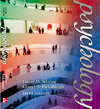 |
1 |  | 
In psychoanalytic theory, the defense mechanism that involves banishing threatening thoughts, feelings, and memories into the unconscious mind is known as: |
|  | A) | repression |
|  | B) | pleasure principle |
|  | C) | reality principle |
|  | D) | rationalization |
 |
 |
2 |  | 
In Freud's theory, the part of the personality that helps the individual adapt to external reality by making compromises between the id, the superego, and the environment is the: |
|  | A) | ego |
|  | B) | pleasure principle |
|  | C) | reality principle |
|  | D) | rationalization |
 |
 |
3 |  | 
The process by which the ego directs the individual to express sexual and aggressive impulses in socially acceptable ways is (the): |
|  | A) | repression |
|  | B) | pleasure principle |
|  | C) | reality principle |
|  | D) | rationalization |
 |
 |
4 |  | 
According to Freud, the _____ mind includes accessible memories, which can be recalled at will. |
|  | A) | conscious |
|  | B) | preconscious |
|  | C) | unconscious |
|  | D) | psychic determinism |
 |
 |
5 |  | 
The notion of _____ holds that all behavior is influenced by unconscious motives, as is exhibited in Freudian slips. |
|  | A) | conscious |
|  | B) | preconscious |
|  | C) | unconscious |
|  | D) | psychic determinism |
 |
 |
6 |  | 
According to Freud, a process that distorts reality to prevent the individual from being overwhelmed by anxiety is known as: |
|  | A) | defense mechanism |
|  | B) | projection |
|  | C) | psychic determinism |
|  | D) | the unconscious |
 |
 |
7 |  | 
In psychoanalytic theory, ______ is the defense mechanism that involves expressing feelings toward a person who is less threatening than the person who is the true target. |
|  | A) | regression |
|  | B) | rationalization |
|  | C) | projection |
|  | D) | displacement |
 |
 |
8 |  | 
The defense mechanism known as ____ involves attributing one's own undesirable feelings to other people. |
|  | A) | regression |
|  | B) | rationalization |
|  | C) | projection |
|  | D) | displacement |
 |
 |
9 |  | 
According to Freud, ____ is the defense mechanism that involves reverting to immature behaviors that have relieved anxiety in the past. |
|  | A) | regression |
|  | B) | rationalization |
|  | C) | projection |
|  | D) | displacement |
 |
 |
10 |  | 
Which of these is the most successful defense mechanism according to Freud? |
|  | A) | reaction formation |
|  | B) | sublimation |
|  | C) | fixation |
|  | D) | displacement |
 |
 |
11 |  | 
According to Freud's theory of psychosexual development, the stage between age five and puberty, during which there is little psychosexual development is the: |
|  | A) | oral stage |
|  | B) | anal stage |
|  | C) | phallic stage |
|  | D) | latent stage |
 |
 |
12 |  | 
Which of these projective tests uses the perception of inkblots to assess respondents' personality types? |
|  | A) | Minnesota Multiphasic Personality Inventory |
|  | B) | Myers-Briggs Type Indicator Test |
|  | C) | Thematic Apperception Test |
|  | D) | Rorshach Test |
 |
 |
13 |  | 
A person who is socially outgoing and prefers to pay attention to the external environment is an: |
|  | A) | introvert type |
|  | B) | extrovert type |
|  | C) | archetype type |
|  | D) | inferiority type |
 |
 |
14 |  | 
According to Eysenck's three-factor theory of personality, which one of the following factors refers to a person's level of stability/instability? |
|  | A) | extraversion |
|  | B) | conscientiousness |
|  | C) | neuroticism |
|  | D) | psychoticism |
 |
 |
15 |  | 
The concept of ____ reflects Bandura's belief that neither personal dispositions nor environmental factors can by themselves explain behavior, but instead assumes cognitive factors, environmental factors, and overt behavior affect one another. |
|  | A) | behavioral aggregation |
|  | B) | self-monitoring |
|  | C) | self-efficacy |
|  | D) | reciprocal determinism |
 |



 2002 McGraw-Hill Higher Education
2002 McGraw-Hill Higher Education

 2002 McGraw-Hill Higher Education
2002 McGraw-Hill Higher Education